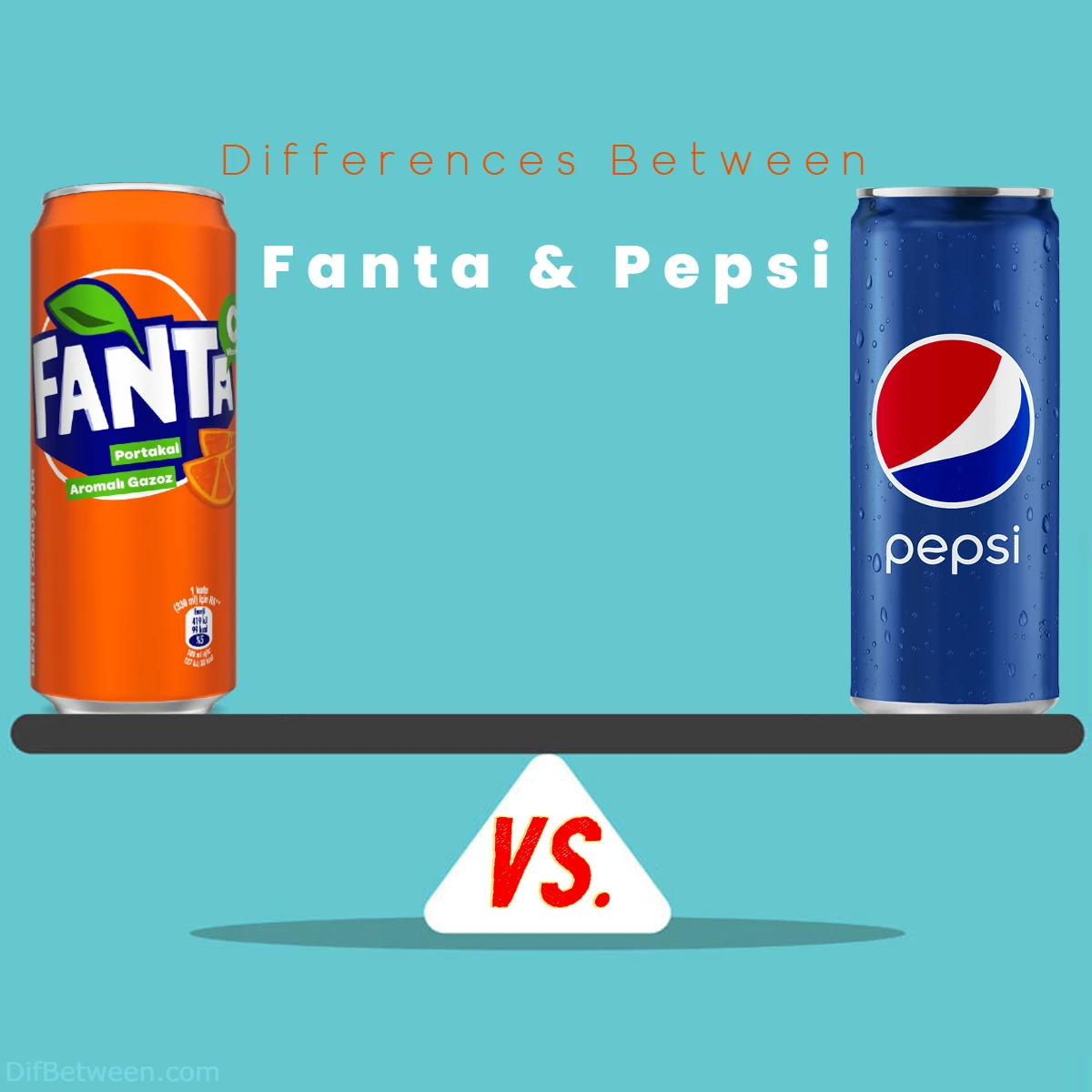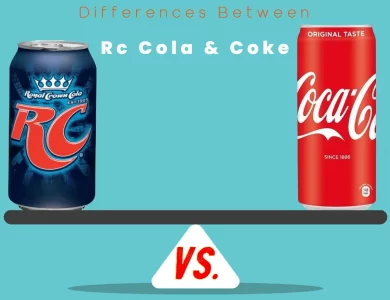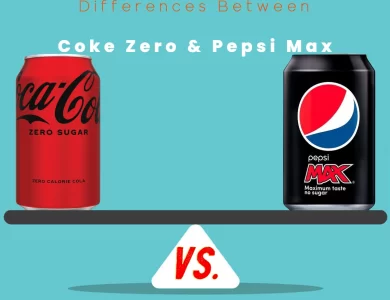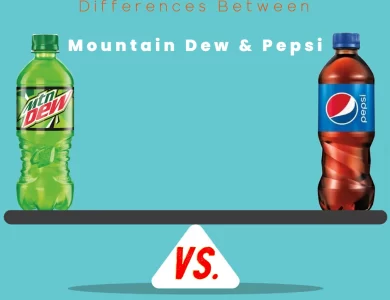
| Aspect | Fanta | Pepsi |
|---|---|---|
| Origin | Created during World War II in Germany as a creative solution for Coca-Cola’s ingredient shortage. | Invented by Caleb Bradham in the late 19th century and officially named Pepsi-Cola in 1898. |
| Flavor Profile | Fruit-inspired with flavors like orange, grape, pineapple, strawberry, and more. | Classic cola taste with variations like Pepsi Wild Cherry, Pepsi Vanilla, and more. |
| Ingredients | Real fruit flavors, carbonated water, high fructose corn syrup (or artificial sweeteners in diet versions), citric acid, natural flavors, preservatives. | Carbonated water, high fructose corn syrup (or artificial sweeteners in diet versions), caramel color, phosphoric acid, natural flavors, caffeine. |
| Target Audience | Emphasizes fun and youthfulness, appealing to the young and the young-at-heart. | Attracts a broader audience, often positioning itself as a youthful and energetic beverage. |
| Global Availability | Widespread global presence with region-specific flavors. | Widely distributed worldwide, with localized and regional variants available. |
| Packaging | Colorful and playful design, often featuring images of fruits or playful graphics. | Timeless and iconic design with the classic blue backdrop and circular logo. |
| Cultural Significance | Celebratory beverage with regional flavors tied to cultural events. | Beverage for social bonding, often associated with sharing moments with friends and family. |
| Environmental Impact | The Coca-Cola Company has been working towards sustainability with eco-friendly packaging and conservation efforts. | PepsiCo has taken steps to address environmental impact through emission reduction and recycling initiatives. |
| Market Share | A significant player in the flavored carbonated beverage segment with a strong distribution network. | A formidable competitor in the cola market with diversified product offerings. |
Now that we’ve spilled the soda secrets, it’s time for you to quench your thirst for knowledge. Taste the vibrant world of Fanta, embracing playful flavors that tickle your taste buds, or savor the classic allure of Pepsi’s cola magic. Whether you’re an adventure-seeking Fanta fanatic or a loyal follower of Pepsi’s timeless taste, the choice is yours to make. So, let your taste buds guide you and indulge in the refreshing experience that suits your fancy. Cheers to a world of fizzy fun! Keep exploring, and don’t forget to end your thirst at your favorite soda’s blissful destination!
Differences Between Fanta and Pepsi
History and Origins
Fanta: Embracing Creativity
Fanta, that zesty orange delight, has an intriguing history that dates back to the 1940s. Created during World War II when Coca-Cola faced a shortage of ingredients in Nazi Germany, Fanta emerged as a creative solution. The word “Fanta” itself is derived from the German word “Fantasie,” meaning “fantasy” or “imagination,” signifying the brand’s essence – a whimsical and imaginative beverage.
Over the years, Fanta expanded its horizons and introduced a wide array of fruit flavors, appealing to diverse palates worldwide. Today, it boasts a vibrant lineup featuring flavors like grape, pineapple, strawberry, and more.
Pepsi: The Cola Challenge
Pepsi, the arch-rival of Coca-Cola, has a rich history of competition in the cola industry. Introduced in the late 19th century as “Brad’s Drink” by Caleb Bradham, the beverage underwent a series of rebranding before being officially named Pepsi-Cola in 1898. Its name, “Pepsi,” is believed to have been inspired by the digestive enzyme pepsin and kola nuts, key ingredients in the original recipe.
Similar to Fanta, Pepsi expanded its flavor range beyond the classic cola, introducing variations like Pepsi Twist, Wild Cherry Pepsi, and more. The ongoing cola wars between Pepsi and Coca-Cola have given birth to countless iconic ad campaigns, capturing the hearts of consumers globally.
Flavor Profiles
Fanta: The Fruity Zing
At the heart of Fanta’s charm lies its fruit-inspired flavor profile. The original Fanta Orange presents a tangy and sweet combination, mimicking the taste of ripe oranges in a bubbly format. The effervescence enhances the experience, leaving taste buds tantalized and refreshed. Besides the classic orange, Fanta’s diverse range of flavors caters to a wide spectrum of taste preferences.
Here are some popular Fanta flavors and a brief description of their taste:
| Flavor | Taste Profile |
|---|---|
| Grape | Sweet and juicy with a hint of tartness |
| Pineapple | Tropical and mildly tangy |
| Strawberry | Sweet and luscious, reminiscent of berries |
| Green Apple | Crisp, slightly tart, and refreshing |
Pepsi: The All-American Classic
Pepsi, on the other hand, is the epitome of the classic cola flavor we all know and love. Its signature blend of carbonation, caramel, sweeteners, and a touch of citrus offers a balanced and smoother taste compared to its main competitor, Coca-Cola. The cola flavor profile dances between sweet and slightly spicy, making it a timeless favorite among soda enthusiasts.
In addition to the classic Pepsi cola, the brand also offers various flavored variants, each putting a unique twist on the iconic taste:
| Flavor | Taste Profile |
|---|---|
| Pepsi Wild Cherry | A burst of cherry sweetness complementing the cola base |
| Pepsi Vanilla | Creamy and smooth with a delightful hint of vanilla |
| Pepsi Zero Sugar | A calorie-free option with the classic Pepsi taste |
| Pepsi Lime | A zesty and tangy experience with a splash of lime |
Ingredients
Fanta: Embracing the Fruit Essence
Fanta prides itself on using real fruit flavors, which sets it apart from many other sodas in the market. While the specific ingredients might vary slightly depending on the flavor, let’s take a look at the general components found in the classic Fanta Orange:
- Carbonated Water: The base that gives Fanta its bubbly nature.
- High Fructose Corn Syrup (HFCS): A common sweetener in soft drinks.
- Citric Acid: Provides tartness and enhances the fruit flavor.
- Natural Flavors: Derived from real fruits to create the authentic taste.
- Sodium Benzoate: A preservative to maintain freshness.
- Potassium Sorbate: Another preservative to prevent spoilage.
Please note that Fanta also offers some diet versions that replace high fructose corn syrup with artificial sweeteners for calorie-conscious consumers.
Pepsi: The Classic Cola Blend
Pepsi’s ingredients are centered around achieving its distinctive cola taste. While formulations may vary slightly depending on the variant and region, here’s a glimpse of the common components found in Pepsi Cola:
- Carbonated Water: The base for that essential fizziness.
- High Fructose Corn Syrup (HFCS): The primary sweetener for the classic Pepsi.
- Caramel Color: Provides the recognizable cola hue.
- Phosphoric Acid: Balances the sweetness and adds acidity.
- Natural Flavors: Blended to achieve the characteristic Pepsi taste.
- Caffeine: A key ingredient that contributes to its energizing effect.
Like Fanta, Pepsi offers diet versions such as Pepsi Zero Sugar, which substitutes HFCS with artificial sweeteners.
Target Audience and Marketing
Fanta: Embracing Fun and Youthfulness
Fanta’s marketing strategy revolves around evoking a sense of playfulness and fun. The brand positions itself as the go-to drink for the young and the young-at-heart, celebrating life’s enjoyable moments. Fanta’s advertisements often feature vibrant colors, catchy tunes, and themes centered around joy and spontaneity. This approach has resonated with teens and young adults, cementing Fanta’s status as a popular choice for parties and gatherings.
The brand frequently collaborates with popular influencers, runs engaging social media campaigns, and sponsors events that align with its brand identity. By staying culturally relevant and embracing digital platforms, Fanta maintains its connection with its target audience.
Pepsi: A Brand for Every Generation
Pepsi, with its long-standing presence in the market, has a broader target audience that spans across different age groups. The brand’s marketing campaigns are known for their star-studded appeal, featuring famous celebrities and athletes from various fields. These endorsements have contributed to Pepsi’s image as a youthful and energetic beverage.
At times, Pepsi’s advertising focuses on social issues and cultural themes, aiming to connect with consumers on a deeper level. Moreover, the brand actively engages in sponsorships, partnering with major sports events, music festivals, and entertainment extravaganzas, further expanding its reach.
Global Availability and Variants
Fanta: A World of Flavors
Fanta, as part of The Coca-Cola Company, boasts a widespread global presence. The brand has managed to localize its flavors to cater to regional tastes effectively. While Fanta Orange remains a popular choice worldwide, different countries offer their unique Fanta variants. For instance, Fanta Lychee is popular in China, Fanta Shokata (elderflower-lemon) in Europe, and Fanta Melon Cream Soda in Japan.
This regionalization of flavors has allowed Fanta to become an international hit, offering consumers the chance to explore various taste experiences from around the globe.
Pepsi: Embracing Diversity
Pepsi, as one of the leading soda brands worldwide, has achieved remarkable global distribution. It is available in almost every corner of the world, offering the classic cola flavor as well as various localized and region-specific variants.
PepsiCo, the parent company of Pepsi, has diversified its portfolio to include non-cola beverages like Mountain Dew, 7UP, and Lipton Iced Tea. This diversification strategy allows the brand to cater to different preferences, ensuring there’s a Pepsi product for every taste.
Nutritional Considerations
Fanta: A Sweet Indulgence
As with most sodas, Fanta is not known for its nutritional benefits. It contains a significant amount of added sugars, usually in the form of high fructose corn syrup. While it offers a delightful taste experience, it’s essential to consume Fanta in moderation due to its high sugar content. For individuals watching their calorie intake or with dietary restrictions related to sugar, Fanta also offers diet versions containing artificial sweeteners.
Pepsi: Moderation is Key
Similarly, Pepsi is not a beverage that provides substantial nutritional value. It contains high fructose corn syrup as the primary sweetener, contributing to its calorie content. Additionally, Pepsi contains caffeine, which can impact some individuals differently.
For those concerned about sugar intake or calorie control, Pepsi Zero Sugar is a suitable alternative. However, like with any artificially sweetened beverage, it’s essential to consume it in moderation.
Packaging and Design
Fanta: Colorful and Playful
Fanta’s packaging exudes vibrancy and playfulness, perfectly reflecting the brand’s ethos. The iconic bright orange hue dominates its cans and bottles, instantly catching the eye of consumers on store shelves. The brand often incorporates images of fruits or playful graphics related to its flavors, reinforcing the idea of a fruity and fun-filled beverage. Fanta’s design strategy plays a significant role in attracting younger audiences and creating a sense of excitement around the product.
Pepsi: Timeless and Iconic
Pepsi’s packaging has evolved over the years, but the brand has maintained a sense of timelessness and iconic appeal. The classic blue backdrop with the iconic red, white, and blue circular logo remains a consistent feature across its range. Pepsi’s packaging is instantly recognizable, making it stand out on the crowded shelves of supermarkets and stores. The design exudes a sense of reliability and familiarity, appealing to consumers of all ages who seek the comfort of a beloved cola.
Cultural and Regional Significance
Fanta: A Global Connector
Fanta has managed to establish cultural significance in various regions worldwide. In many countries, Fanta has become synonymous with celebration, making appearances at festivals, parties, and gatherings. In some cultures, specific Fanta flavors hold cultural importance, often associated with seasonal festivities or traditional events. For example, Fanta Grape is a popular choice during Chinese New Year celebrations in some Asian countries.
Pepsi: A Beverage for Social Bonding
Pepsi’s cultural significance lies in its role as a beverage of social bonding. In many cultures, sharing a Pepsi with friends and family is a common way to enjoy social moments and build connections. The brand’s celebrity endorsements and sponsorship of major events further solidify its place in popular culture. Additionally, Pepsi has occasionally collaborated with artists and musicians to create limited-edition packaging and advertising campaigns that resonate with specific cultural contexts.
Environmental Impact
Fanta: A Commitment to Sustainability
The Coca-Cola Company, which owns Fanta, has been working towards improving its environmental impact over the years. They have set ambitious goals to reduce their carbon footprint, promote recycling initiatives, and conserve water resources. Additionally, Coca-Cola has been making efforts to introduce more eco-friendly packaging, including plant-based bottles and recyclable materials.
Pepsi: Advancing Environmental Stewardship
PepsiCo, the parent company of Pepsi, has also taken significant steps to address its environmental impact. The company has made commitments to reduce greenhouse gas emissions, improve water efficiency, and increase the use of renewable energy sources in its operations. PepsiCo has been actively involved in recycling initiatives and sustainable sourcing practices for its packaging materials.
Fanta: A Coca-Cola Companion
As part of The Coca-Cola Company, Fanta enjoys the support of a global beverage giant. It benefits from a vast distribution network and extensive marketing resources. Fanta’s fruity flavors and appeal to younger demographics have helped it carve out a significant market share in the flavored carbonated beverage segment.
Pepsi: A Strong Contender
Pepsi, as one of Coca-Cola’s main competitors, is a formidable player in the soda market. The ongoing cola wars between Pepsi and Coca-Cola have kept both brands on their toes, continuously innovating and investing in advertising to win over consumers. Pepsi’s diversified product portfolio and its ability to appeal to different demographics have contributed to its sustained competitiveness in the industry.
The Ultimate Decision: Fanta or Pepsi?
Now that we’ve explored the key differences between Fanta and Pepsi, you might find yourself faced with a delightful dilemma – which one should you choose? The answer ultimately depends on your personal taste preferences and the occasion. Let’s break it down to help you make an informed decision:
Choose Fanta if:
- You Crave Fruity Zest: If you enjoy the vibrant and fruity taste experience, Fanta is your go-to choice. Its assortment of flavors, from classic orange to exotic options like grape and pineapple, allows you to indulge in a range of refreshing fruit-inspired delights.
- You Embrace Playfulness: Fanta’s playful and whimsical branding appeals to the young and the young-at-heart. If you’re looking to add a splash of fun to your gatherings or celebrations, Fanta’s vibrant packaging and fruity fizz are sure to bring a smile to your face.
- You Want to Explore Regional Flavors: Fanta’s global presence means you can explore various regional and country-specific flavors, each offering a unique and exciting taste adventure.
- You Seek a Calorie-Conscious Option: Fanta offers diet versions with artificial sweeteners, providing a calorie-free alternative for those looking to enjoy their favorite fruity soda without the guilt.
Choose Pepsi if:
- You Love the Classic Cola Taste: If you’re a fan of the timeless cola flavor, Pepsi’s smooth and balanced taste will surely satisfy your cravings. Its signature blend of carbonation, caramel, and sweeteners delivers a refreshing and familiar experience.
- You Enjoy Versatility: Pepsi’s product range extends beyond the classic cola, offering various flavored variants like Pepsi Wild Cherry and Pepsi Vanilla. This variety allows you to choose the perfect Pepsi to suit your mood.
- You Appreciate Iconic Branding: Pepsi’s iconic blue packaging and circular logo evoke a sense of familiarity and nostalgia, making it a timeless and trusted choice for soda enthusiasts worldwide.
- You Prefer a Low-Calorie Option: Opt for Pepsi Zero Sugar if you’re watching your sugar intake or looking for a calorie-free option without compromising on the classic cola taste.
Final Thoughts
Ultimately, the choice between Fanta and Pepsi boils down to your individual taste preferences, the occasion, and the flavors that excite your palate. Both beverages offer a range of options to cater to various tastes and dietary needs, ensuring there’s a soda for everyone.
Whether you’re in the mood for a fruity burst of Fanta’s zest or the classic and reliable taste of Pepsi’s cola, both sodas promise a refreshing and enjoyable experience. So go ahead, choose the one that tickles your taste buds, and savor every fizzy moment! And remember, moderation is key to enjoy these delightful beverages responsibly. Cheers!
FAQs
Fanta is known for its fruit-inspired flavors like orange, grape, pineapple, and more, offering a zesty and refreshing taste. Pepsi, on the other hand, features a classic cola flavor with variations like Pepsi Wild Cherry and Pepsi Vanilla, providing a smooth and balanced taste experience.
Yes, the ingredients differ between the two. Fanta includes real fruit flavors, carbonated water, high fructose corn syrup (or artificial sweeteners in diet versions), citric acid, natural flavors, and preservatives. Meanwhile, Pepsi contains carbonated water, high fructose corn syrup (or artificial sweeteners in diet versions), caramel color, phosphoric acid, natural flavors, and caffeine.
Fanta aims to appeal to the young and the young-at-heart, emphasizing playfulness and fun, making it popular among teens and young adults. Pepsi’s target audience is more diverse, positioning itself as a youthful and energetic beverage, attracting consumers of various age groups.
Yes, both Fanta and Pepsi have a widespread global presence. Fanta offers region-specific flavors, allowing consumers to explore diverse tastes from around the world. Pepsi, too, is available in almost every corner of the globe, making it easily accessible.
Both Fanta and Pepsi’s parent companies have taken steps to address their environmental impact. They have committed to reducing carbon emissions, promoting recycling initiatives, and introducing eco-friendly packaging.
Fanta’s fruity flavors are often associated with celebration and cultural events in various regions. Pepsi, on the other hand, holds significance as a beverage for social bonding, often enjoyed during shared moments with friends and family.
The choice depends on your taste preferences and the occasion. If you crave fruity zest and playfulness, Fanta is a great option. If you love the classic cola taste and versatility, Pepsi might be your ideal choice. Choose the one that best suits your fancy and enjoy your fizzy delight responsibly!
Yes, both Fanta and Pepsi offer diet versions with artificial sweeteners, providing low-calorie alternatives for those mindful of their sugar intake.
Fanta stands out with its creative and imaginative flavors, while Pepsi’s timeless cola taste and iconic branding contribute to its distinct appeal, making them two beloved soda brands globally.
Mixing Fanta and Pepsi can create a custom flavor blend, offering a fun and adventurous taste experience. Give it a try and discover your own fizzy concoction!
Read More:





